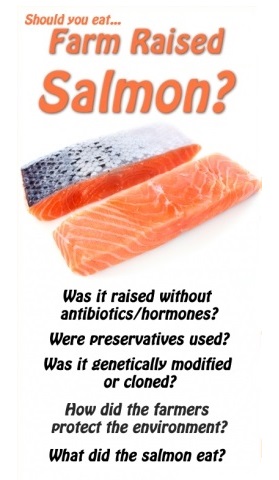-
Ask the Nutritionist: Farmed vs. Wild Salmon
Thursday, December 11th, 2025by Kristin Kirkpatrick, MS, RD, LD
Debating the Health Benefits and Risks of Farmed vs. Wild Salmon
Every shopping trip to the local organic market comes with trade-offs. Which kind of bread should you buy? Do those eggs really come from free-range chickens?
 One of the hardest decisions you have to make comes when you reach the seafood section.
One of the hardest decisions you have to make comes when you reach the seafood section. Everyone knows that fish like salmon and trout contain abundant amounts of omega-3 fatty acids and offer many health benefits.
However, there are also alarming stories about the contaminants and risks of eating these types of fish. What is a health-conscious consumer to do?
As the world’s fish stocks have declined, farmed fish has become more common. Yet the debate over farmed vs. wild fish continues despite years of research and information campaigns to help educate consumers.
The key question is, should consumers risk the downside of eating farmed fish (contaminants and their potentially negative effects on health) … for the upside (an excellent source of omega-3 fatty acids, more affordable, greater availability and, to some folks, better taste)?
What follows below is a detailed overview of the health benefits and risks of eating farmed salmon vs. wild salmon.
#1: Nutritional Content: Farmed vs. Wild Salmon
According to USDA data, there are some key nutritional differences between farmed and wild salmon.
A small fillet of farmed salmon has 131 more calories and twice the fat content of the same amount of wild salmon.
And while wild salmon may have slightly fewer omega-3 fatty acids, it also has 20.5 percent less saturated fat content.
And we can all do with eating less bad fat!
Nutritional bottom line: Wild salmon gets the nod for having less saturated fat and fewer calories than farmed salmon.
#2: Farmed Salmon Contains Risky Pollutants
Persistent Organic Pollutants (also known as POPs) sound dangerous, and they most certainly are.
POPs have been linked to a variety of diseases, including obesity and type-2 diabetes.
Research suggests obesity might be an enhanced risk factor for diabetes when POPs are present in the human body.
Moreover, specific types of POPs raise the risk of stroke in women.
Why is this important? It’s because PCB levels (PCB is one type of POP) are 5 to 10 times higher in farmed fish than they are in wild fish.
Conclusion? Wild salmon takes the prize, and it’s no contest.
#3: Cancer-Causing Chemicals in Salmon
In the farmed vs. wild fish debate, this is a complicated issue.
Although both wild and farmed fish contain omega-3 fatty acids, consuming either type of fish in large amounts may end up exposing you to cancer-causing chemicals.
The source of these chemicals is the polluted water the fish swim in.
And it’s further evidence of why one’s sources of omega-3’s need to be varied, with fish as only one part of the broader equation.
However, one study does reach the conclusion that “the benefit-risk ratio for carcinogens and non-carcinogens is significantly greater for wild salmon than for farmed salmon.”
Key takeaway: Both farmed and wild salmon carry risks if eaten in large amounts. But when eaten in moderation, wild salmon is the safer choice.
#4: Other Dangerous Contaminants in Salmon
In recent studies contaminants were found to be generally higher in farmed salmon than in wild salmon.
The levels of contaminants were below the approved U.S. Food and Drug Administration (FDA) tolerances, but they still surpassed the levels considered safe “for frequent consumption” by the Environmental Protection Agency (EPA).
As a corollary, other research has suggested that children, women of child-bearing age and pregnant women should opt for wild salmon — or other good sources of omega-3 fatty acids.
The bottom line: Both farmed and wild salmon contain dangerous contaminants, but wild salmon has them in lower amounts and is considered safer overall.
#5: Antibiotics in Salmon: A Valid Concern?
Antibiotics in salmon created a major debate in the late 1990s and early 2000s, when Chilean salmon imports to Japan were found to have higher antibiotic amounts than allowed under government regulations.
The reason for worry? Too much exposure to antibiotics could lead to antibiotic resistance in humans.
Antibiotic use in farmed fish is thought to have since been reduced, but it is not clear at what level such antibiotic use continues.
What it means: Uncertainty about antibiotic use is a major question with farmed salmon. Wild salmon is antibiotic-free.
Conclusion: Keep It Wild
Both farmed and wild salmon contain important nutrients the body needs. But it is becoming more and more evident that the risks associated with farmed fish are higher than those with wild fish.
If you want to take advantage of the many health benefits fish such as salmon provide, your best bet is to keep it wild.
(published March 5, 2014)
 Kristin Kirkpatrick is a registered dietitian and wellness manager for the Cleveland Clinic Wellness Institute. She is a regular contributor to the “Doctor Oz Show” and provides expert opinions for several major magazines as well as media and web outlets. Kristin’s articles also appear on Cleveland Clinic’s Health Hub, a consumer health and wellness blog. Kristin has been helping individuals reach their personal health goals for over 12 years and her specialties include weight management, nutritional genomics, dieting on a budget and community-worksite wellness.
Kristin Kirkpatrick is a registered dietitian and wellness manager for the Cleveland Clinic Wellness Institute. She is a regular contributor to the “Doctor Oz Show” and provides expert opinions for several major magazines as well as media and web outlets. Kristin’s articles also appear on Cleveland Clinic’s Health Hub, a consumer health and wellness blog. Kristin has been helping individuals reach their personal health goals for over 12 years and her specialties include weight management, nutritional genomics, dieting on a budget and community-worksite wellness.


